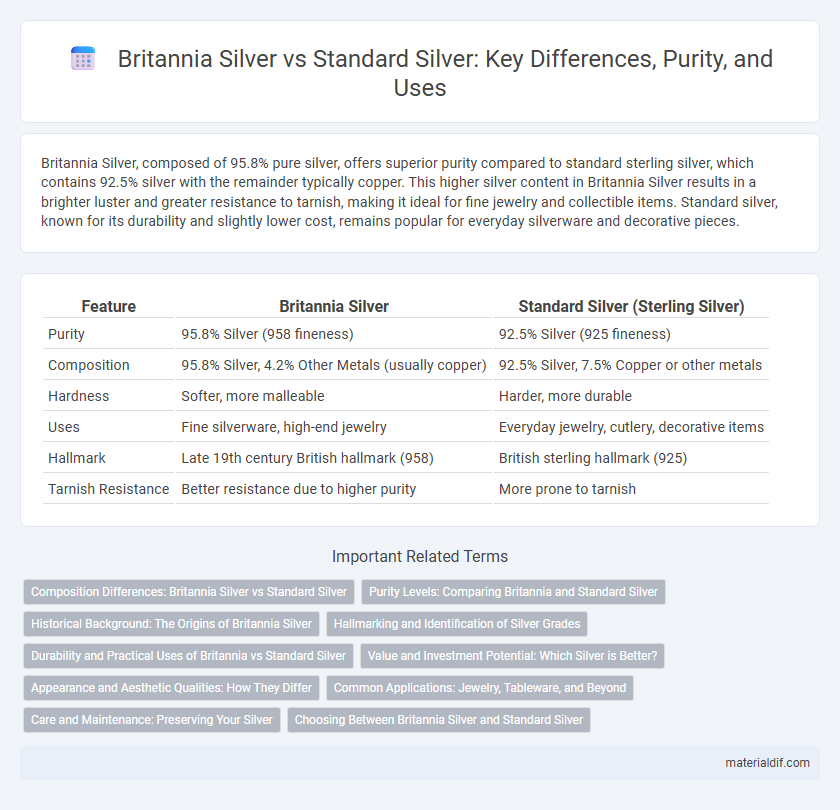Britannia Silver, composed of 95.8% pure silver, offers superior purity compared to standard sterling silver, which contains 92.5% silver with the remainder typically copper. This higher silver content in Britannia Silver results in a brighter luster and greater resistance to tarnish, making it ideal for fine jewelry and collectible items. Standard silver, known for its durability and slightly lower cost, remains popular for everyday silverware and decorative pieces.
Table of Comparison
| Feature | Britannia Silver | Standard Silver (Sterling Silver) |
|---|---|---|
| Purity | 95.8% Silver (958 fineness) | 92.5% Silver (925 fineness) |
| Composition | 95.8% Silver, 4.2% Other Metals (usually copper) | 92.5% Silver, 7.5% Copper or other metals |
| Hardness | Softer, more malleable | Harder, more durable |
| Uses | Fine silverware, high-end jewelry | Everyday jewelry, cutlery, decorative items |
| Hallmark | Late 19th century British hallmark (958) | British sterling hallmark (925) |
| Tarnish Resistance | Better resistance due to higher purity | More prone to tarnish |
Composition Differences: Britannia Silver vs Standard Silver
Britannia Silver consists of 95.8% pure silver, making it purer than Standard Silver, which typically contains 92.5% silver as sterling silver. The higher silver content in Britannia Silver results in a softer metal with a distinct bright white appearance compared to the slightly more durable and harder sterling standard. These composition differences directly affect the metal's use in jewelry, silverware, and investment-grade silver products.
Purity Levels: Comparing Britannia and Standard Silver
Britannia silver is composed of 95.83% pure silver, significantly higher than standard sterling silver, which contains 92.5% pure silver by alloy composition. The increased purity level in Britannia silver results in a softer metal with a whiter appearance, making it ideal for intricate silverware and fine jewelry. Despite its softness, Britannia silver offers superior tarnish resistance compared to sterling silver, enhancing its durability for lasting aesthetic appeal.
Historical Background: The Origins of Britannia Silver
Britannia Silver originated in 1697 in England as a high-quality silver standard containing 95.8% pure silver, established to curb coin clipping and promote trade integrity. Unlike Standard Silver, which contains 92.5% silver (sterling silver), Britannia Silver was mandated for all silverware to ensure greater purity during that period. Its hallmark, a figure of Britannia, symbolized royal approval and set a distinct standard for British silver craftsmanship.
Hallmarking and Identification of Silver Grades
Britannia Silver is marked with a 958 hallmark, indicating 95.8% pure silver, making it more refined than Standard Silver, which is typically marked with a 925 hallmark, denoting 92.5% purity or sterling silver. Hallmarking for both types is regulated to ensure authenticity and composition, with Britannia Silver often identified by its unique lion hallmark or Britannia figure. The hallmarking system aids buyers and sellers in distinguishing between higher-purity Britannia Silver and the more common sterling silver alloys used in jewelry and silverware.
Durability and Practical Uses of Britannia vs Standard Silver
Britannia silver, composed of 95.8% pure silver, offers superior durability compared to standard sterling silver, which contains 92.5% silver mixed with copper. This higher purity results in a softer metal but is often balanced by Britannia silver's enhanced resistance to tarnish, making it ideal for fine tableware and ornamental pieces requiring long-lasting luster. Standard silver, with its greater hardness, is preferred for everyday items like jewelry and flatware that endure frequent handling and require increased strength.
Value and Investment Potential: Which Silver is Better?
Britannia silver, composed of 95.83% pure silver, offers higher intrinsic value compared to standard silver, which typically contains 92.5% pure silver (sterling silver). The increased silver content in Britannia silver enhances its investment potential by ensuring greater purity and durability, making it more attractive to collectors and investors seeking long-term value preservation. Market demand and legal tender status also influence the premium price and liquidity of Britannia silver over standard silver.
Appearance and Aesthetic Qualities: How They Differ
Britannia Silver, with a purity of 95.8%, exhibits a brighter and whitish sheen compared to Standard Silver, which typically contains 92.5% pure silver and appears slightly grayer. The higher silver content in Britannia Silver lends it a smoother and more lustrous surface, enhancing its appeal in fine jewelry and decorative items. Standard Silver's alloy mix gives it greater durability but results in a darker tone and less reflective finish.
Common Applications: Jewelry, Tableware, and Beyond
Britannia silver, composed of 95.8% pure silver, is frequently used in high-end jewelry and premium tableware due to its superior purity and bright luster that resists tarnishing. Standard silver, typically sterling silver with 92.5% silver content, remains popular in everyday jewelry, flatware, and decorative objects because of its increased durability from alloyed metals like copper. Both types find extensive application beyond traditional uses, including in collectible coins and luxury electronics components, where silver's conductive and aesthetic properties are critical.
Care and Maintenance: Preserving Your Silver
Britannia Silver, composed of 95.8% pure silver, requires less frequent polishing due to its higher purity compared to Standard Silver, which typically contains 92.5% silver and more alloy metals. Both types benefit from storage in anti-tarnish cloths and regular gentle cleaning with a soft cloth and mild detergent to maintain their luster. Avoiding exposure to harsh chemicals and humidity is crucial for preserving the surface integrity and preventing tarnish formation on either alloy.
Choosing Between Britannia Silver and Standard Silver
Choosing between Britannia Silver and Standard Silver depends on factors like purity and durability, as Britannia Silver contains 95.8% pure silver, compared to the 92.5% purity of Standard Sterling Silver. Britannia Silver is softer and more prone to scratching, making Standard Silver a better option for daily-use items needing greater strength. For collectors and luxury items, the higher purity and distinct look of Britannia Silver often outweigh its reduced durability.
Britannia Silver vs Standard Silver Infographic

 materialdif.com
materialdif.com